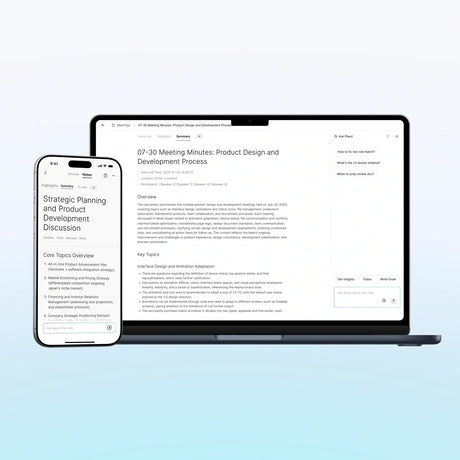Productivity should not be about relentless task execution. Productivity is about focusing on the important things and doing them steadily and with intention.
For project managers, it can feel like a constant juggling act.
You've got shifting priorities, quick decisions to make, and work to squeeze into a busy schedule. Your Zoom meetings are back-to-back, you've got teams on a hybrid model, and you're inundated with digital information...
It is harder than ever to know if you are being productive or just busy.
This guide explores practical tips, focus techniques, and smart tools to help you organize your day, reduce mental fatigue, boost your productivity, and move forward with your assignments.
How to be productive at work: Challenges and strategies
Real productivity starts with identifying the challenges that get in the way of your work. Too many meetings, distractions, backlogs... All of that could be working against your results.
Let’s look at some of the biggest productivity challenges and how to overcome them.
Challenge 1: Too Many meetings & information overload
You start your day in a meeting and end it the same way. In between, you’re juggling decisions, updates, and follow-ups, and somehow, the to-do list only grows. You’re busy the whole day, but feel like nothing got done.

Here’s how to avoid this:
Prioritize efficiency
A good meeting isn't the one that lasts the shortest, but the one that generates clarity. So don't just attend them; show up prepared and stay present. Let Plaud Note record your entire meeting. It automatically transcribes the conversation, giving you a complete and accurate record.

You can then fully participate in the discussion without worrying about missing a word.
Leverage productivity techniques
When the meeting is done, use Plaud Note to analyze it and automatically capture essential decisions, actions, and responsible parties. This saves you hours of time reviewing and lets you zero in on what is most important, even in extensive meetings.

You can easily add these actions to your daily planner or project management tool.
Make to-do lists
Entering a meeting with clear questions and objectives is a simple way to avoid distractions and focus on the essentials. It takes less work to fix things later if they are clear from the start.
Writing down key questions or discussion points will help you stay on topic and cover the most important things, even if it's just a rough draft you made the night before.
Challenge 2: Constant interruptions & difficulty focusing
Notifications, messages, a quick “you got a sec?” on Slack… These small interruptions might seem harmless, but getting back on track after stopping to check on them takes longer than anyone wants to admit.

Here’s how to avoid this:
Limit distractions
It sounds basic, but it works: put your phone out of reach. Close the 14 tabs you don’t need. Mute the non-urgent chats. Your brain will thank you.
You can also turn on “Do Not Disturb” mode and set times to check social media or respond to messages. Instead of being constantly available, choose to be 100% focused during well-defined blocks of time.
This will stop your brain from multitasking and encourage a state of deep concentration.
Work effectively
Organize your day into blocks of time in which you devote your attention to work when you are scheduled to. This allows you to cultivate and engage in a productive “flow state” while maximizing your work output both in speed and quality.
This intentional approach helps you build sharper focus, solve problems more efficiently, and sustain high performance in your work.
Don't break your flow
Try to avoid taking breaks that negatively influence your thinking during complex tasks. The more focus you employ, the larger the cost of the break will be to your concentration.
When a thought or question pops up at an inopportune time, use a voice recorder like Plaud NotePin to record it so you can stay in the flow instead of letting it distract you.
Challenge 3: Managing many projects at once & prioritization paralysis
When everything seems urgent, it can be difficult to decide where to start. Constant busyness without real progress can be frustrating, especially when, no matter how much you accomplish, the to-do list just keeps growing.

Shift your mindset
Procrastination is not laziness. In many cases, it is a feeling of being overwhelmed.
Acknowledge and stop procrastination, consciously deciding to break the cycle of putting things off. You can also create a mantra or vision statement. Define your goals for managing projects effectively and affirm them daily.
Your subconscious mind will start to align with these positive statements.
Plan around your energy
Figure out when your brain is sharpest, morning, afternoon, or whenever you feel productive, and protect that time. Use it for deep work, big decisions, or tricky tasks. Save admin or shallow work for later.
Additionally, make sure to take a real break after finishing a major project. You’ve earned it.
Leverage proven productivity techniques
Methods like time blocking and Pomodoro help transform intention into action. In the former, you set aside fixed blocks of time for specific activities. In the latter, you alternate periods of intense focus with short breaks.
Both work best when adhered to consistently and when you use these breaks to breathe, not to overwhelm yourself.
Challenge 4: Keeping teams accountable & scope creep
Projects don't spiral out of control overnight. They accumulate overlooked details, unowned tasks, and undocumented changes.
When everything seems to be moving forward, but nothing is clear, team productivity suffers. Here’s how to avoid this:

Use smart support tools
Instead of playing catch-up, use Plaud Note to keep a real-time record of decisions, deadlines, and action items during meetings. You stay focused on the conversation, and the tool keeps track of the rest.
Create follow-up rituals
Don't wait for a delay to react. Set aside fixed blocks of time to review pending tasks, align expectations, and confirm deliveries. Small routine check-ins keep the team moving and avoid surprises.
Make those responsible visible
When responsibilities and deadlines are clear, the entire workflow runs more efficiently. Use shared tools to keep deadlines and responsibilities always accessible to everybody.
Block time for follow-ups
What starts as an adjustment can quickly become a new project. Set aside time in your schedule for scope reviews and course changes. This prevents “small” changes from accumulating uncontrollably.
Pro tip: Create a weekly “scope checkpoint” on your calendar. It works like a preventative cleanup: quick, objective, and essential for keeping you focused on what really matters.
Meeting assistant for project managers: Reclaim your productivity
Lots of project managers spend their days jumping from one call to another. There are also decisions that need to be made, tasks to complete, and updates to stay on top of.
The problem?
It's easy to miss deadlines, revisit conversations, or lose sight of the work that actually matters when there are so many things to do.
That's where a smart meeting assistant like Plaud Note, coupled with an AI membership like Plaud AI Annual Pro Plan or Plaud AI Annual Unlimited Plan, comes in. It helps you manage this volume without relying on memory and without further overloading your routine.

Master the chaos of meetings
In back-to-back meetings, even the most attentive people miss details. A number, a change in deadline, a quick decision… anything can go unnoticed.
Plaud Note solves this with a continuous flow that starts the moment the meeting begins:
- It captures all conversations, without you having to worry about pressing “record”.
- Transcribes accurately, allowing you to review each speech whenever and however you want.
- Summarizes the most important topics, so you understand in minutes what took hours to discuss.
- Highlights tasks, deadlines, and responsible parties, transforming decisions into concrete actions without manual effort.
This way, you save time, reduce rework, and stay clear, even when your schedule doesn't allow for a break.
Organize tasks and follow-ups with less effort
Another challenge is keeping track of everything that's been agreed upon, especially when projects pile up. With Plaud Note, this process happens almost automatically.
During the meeting, while you focus on the conversation, it is already:
- Capturing each task delegation and who was responsible for it
- Organizing these tasks into clear, actionable lists
- Creating a reliable history of decisions that can be consulted whenever a question arises
- And preventing important follow-ups from getting lost along the way
In the end, you have a ready-made checklist, without having to remember everything yourself, and your team knows exactly what to do, without any communication hiccups.
Record ideas without losing focus
In the middle of a complex task, all it takes is an unexpected question or a good idea at the wrong time to break your rhythm. And trying to remember later doesn't always work. Plaud Note comes in as a discreet ally that protects your concentration without letting anything slip.
With it, you can:
- Record a thought as it arises, just speaking it, without interrupting what you are doing
- Avoid opening apps or looking for paper, keeping your attention where it already is
- Create a quick and reliable record of insights and reminders
- And get back to the main task with as little distraction as possible
It's like having a second memory always nearby, ready to store what matters, while you stay focused on what you're doing.
Conclusion: Be productive at work by focusing on what really makes a difference
Productivity isn't about how full your calendar is; it's about making clear future decisions. Once you identify what drives your projects forward, cut out distractions, and automate the rest, your day will run more smoothly.
Use your best energy for what needs strategy, and let tools like Plaud Note do the rest.
How to be productive at work: common questions answered
Why don't I feel like I'm being productive at work?
The problem is often not related to a lack of diligence. It is typically mental fatigue, decision fatigue, or distraction fatigue. Consider organizing your day around energy instead of time.
What is the 1-3-5 method?
It's an easy way to plan your day. You have 1 big task, 3 medium tasks, and 5 small tasks to finish. This strategy keeps your workload manageable while helping you make steady progress on what truly matters.
How can I improve my work productivity?
You need to understand what you need to get done, prevent distractions, and use some tools that will enhance your day. The key is less about doing more; it's more about improving attention on what really matters.
What is the 52/17 rule?
Work 52 minutes, rest 17 minutes. An efficient cycle to maintain focus without draining your attention.






